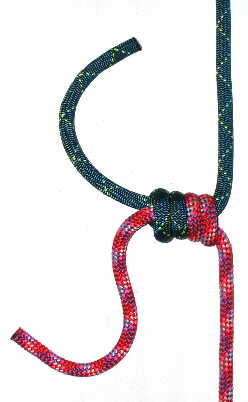EDK vs Flemish Bend for joining two ropes for rappel
|
|
This isn't really anything that needs a debate, but with all the talk of joining ropes for rappel, I only saw a few off-hand comments about the Flemish Bend. Same in a few articles and older discussions too. Why the apparent bias against the Flemish? It's simple enough to tie and only takes a little longer- is the Flemish more likely to get snagged? Not that I have anything against the EDK of course, I've used both knots in certain situations |
|
|
Bingo. Snag and hang-up potential on edges are the main issues. EDK is preferred primarily for it's propensity to get stuck far less often. |
|
|
The flemish bend is awesome, and it's my choice for everything other than joining rap ropes, due to the EDK's lower profile. For everything else, the flemish bend is the way to go. |
|
|
Nolan, |
|
|
What's your input on a double fishermans? Is it the most likely knot to get stuck? As far as strength goes, I'd say it is comparable to the others |
|
|
JoeGaribay wrote:What's your input on a double fishermans? Is it the most likely knot to get stuck? As far as strength goes, I'd say it is comparable to the othersMore likely to get stuck. More difficult to tie/untie I sometimes use a Flat Double Fisherman's. Less likely to get stuck than Double Fisherman's. More difficult to tie/untie that Flat Overhand. Has an odd (but very unlikely, bordering on impossible, IMO) failure mode that other's may point to. |
|
|
The flat overhand bend (edk - which is wrong name) is the standard. |
|
|
layflat double fishermans |
|
|
I use the Flemish blend 100% of the time to join two ropes. It actually has an overall lower profile when compared to a EDK or fishermans. So if the rope wanders over into a crack while you're pulling it has less of a chance of getting caught up. It also has some edge rolling characteristics (though admittedly, won't roll an edge or pass through a biner as easily as a edk) but I think this is a less common snag that the aforementioned scenario. I also prefer a knot that allows you to set it and forget it. Yeah, it may be more "difficult" to untie but there is some confidence in that. |
|
|
Don Ferris wrote:I I also prefer a knot that allows you to set it and forget it.Not a good idea. If one is doing multiple rappels, the knot should be inspected at each rappel station no matter what knot is being used. rob.calm |
|
|
rob.calm wrote: Not a good idea. If one is doing multiple rappels, the knot should be inspected at each rappel station no matter what knot is being used. rob.calmWhy does the figure eight not require inspecting at each belay station when climbing but the flemish bend does? They are the same knot. |
|
|
After the previous thread as well, I'm a little annoyed at the use of the word "profile." Though the EDK is a very small knot, I don't think that's its main benefit. The symmetry (well, lack thereof) is the primary benefit of the EDK. Yes, it's small, but the fact that it has an asymmetrical profile (s^*%, sorry!) is what makes it possible for the knot to get stuck on edges, and in cracks, corners etc, and still release after a few pulls. |
|
|
Flat double fishermans and the Triple Overhandknot Triple flat overhand ( 3 interleaved single fisherman's knots ) |
|
|
Something that was really simple just got really complicated after reading that article. Now I'm really confused. |

 Continue with onX Maps
Continue with onX Maps Continue with Facebook
Continue with Facebook






















